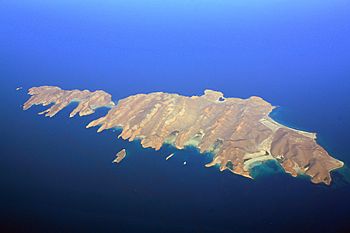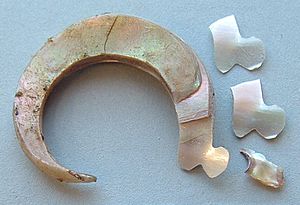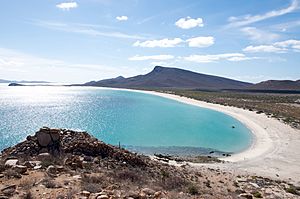Isla Espíritu Santo facts for kids

Aerial view of Isla Espíritu Santo (right) and Isla Partida (left)
|
|
| Geography | |
|---|---|
| Location | Gulf of California |
| Coordinates | 24°28′17″N 110°19′57″W / 24.47139°N 110.33250°W |
| Adjacent bodies of water | Pacific Ocean |
| Area | 80.763 km2 (31.183 sq mi) |
| Administration | |
|
Mexico
|
|
| State | Baja California Sur |
| Municipality | La Paz |
| Demographics | |
| Population | Uninhabited |
Isla Espíritu Santo is a beautiful island in the Gulf of California. It's located off the coast of the Mexican state of Baja California Sur. The island is not inhabited by people. A small, narrow channel separates it from its neighbor, Isla Partida.
Both islands are part of La Paz Municipality. You can reach them by a short boat trip from the city of La Paz. People have lived on this island for a very long time. In fact, humans were present here about 9,000 years ago.
Contents
Island Geography and Formation
Isla Espíritu Santo is found in the Sea of Cortez, also known as the Gulf of California. It is about 26 kilometers (16 miles) south of the port city of La Paz, Mexico. Isla Espíritu Santo and its nearby island, Isla Partida, were formed by powerful earthquakes and volcanoes.
Their rocks are mostly made of volcanic ash and lava. The islands have tall, straight ridges and low valleys. They look like a horizontal rainbow with earthy colors. Espíritu Santo covers an area of about 80.76 square kilometers (31.2 square miles). Its highest point is 562 meters (1,844 feet) tall.
Isla Partida is smaller, with an area of 15.49 square kilometers (6 square miles). Its highest point is 282 meters (925 feet). At its northern end, Espíritu Santo is separated from Partida by a narrow strait. Sometimes, when the tide is right, this strait is shallow enough to walk across. Espíritu Santo is the twelfth largest island in Mexico.
Smaller Islands and Beaches
A few smaller islets are found near the two main islands. Only four of these islets have names. They are Isla Lobos, Isla Ballena, Isla Gallo, and Isla Gallina. The islands also have many beautiful white sandy beaches. These beaches are next to clear, blue waters and steep cliffs.
Island Ecology and Wildlife
Isla Espíritu Santo, Isla Partida, and the sea around them are protected areas. These islands are part of the Islas del Golfo de California Flora and Fauna Protection Area. This makes them a very important place for eco-tourism.
In 1995, UNESCO declared the islands part of a Biosphere Reserve. This means they are special places where nature is protected. Both islands are not inhabited by people. Ensenada Grande beach, on Isla Partida, was once named the most beautiful beach in Mexico. It was also one of the top 12 beaches in the world by The Travel Magazine. Many people enjoy Sea kayaking around the islands.
Unique Animals
Isla Espíritu Santo is the only place in the world where you can find two special animals. These are the black jackrabbit (Lepus insularis) and the Espíritu Santo antelope squirrel (Ammospermophilus insularis).
Marine Life and Birds
The coral reefs around the islands are home to many colorful fish. You can see parrotfish, angelfish, trumpetfish, Moorish idols, and rainbow wrasse. Many other sea creatures also pass by the islands. These include sharks, rays, turtles, dolphins, and even whales.
Many types of birds live here too. You might spot brown pelicans, great blue herons, snowy egrets, turkey vultures, and hummingbirds. A large group of sea lions lives on Los Islotes. This is a small group of rocks off the northern tip of the islands. Snorkeling with the female sea lions and their young is a popular activity for visitors.
Protecting the Islands
In the 1990s, there was a plan to build a resort casino on Isla Espíritu Santo. But many people wanted to protect the island's nature. A group of environmental activists worked together to buy part of the island. They saved it from being developed. This act of conservation is remembered by a sculpture of a dove in La Paz.
In 1994, Espíritu Santo, Partida, and other Gulf of California Islands became a Biosphere Reserve by UNESCO. The Mexican Government made the Gulf of California Islands a flora and fauna protection area in 2000. In 2005, UNESCO named the Gulf of California Islands a World Heritage Site. This means they are very important to the world.
In 2007, the sea area around Espíritu Santo and Partida islands became a marine national park. This park is called Archipiélago Espíritu Santo National Park. It protects an area of 479.9 square kilometers (185.3 square miles).
Ancient Discoveries on the Island

Scientists have found very old fishing tools on Espíritu Santo Island. These are circular fishhooks made from pearl oyster shells. They date back about 8,750 to 8,500 years ago. These hooks were found in a rock shelter on the island called Covacha Babisuri. This is one of the oldest known examples of shell fishhooks in the world.
These ancient fishhooks from Espíritu Santo Island are similar to ones found in other parts of the world. They resemble hooks found in Australia, along the Arabian Sea, and in Valdivia. Similar fishhooks have also been discovered on Cedros Island, which is also in Baja California.
See also
 In Spanish: Isla Espíritu Santo (Baja California Sur) para niños
In Spanish: Isla Espíritu Santo (Baja California Sur) para niños



